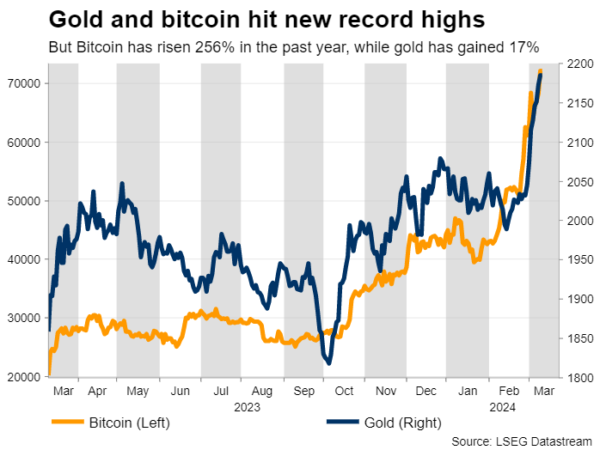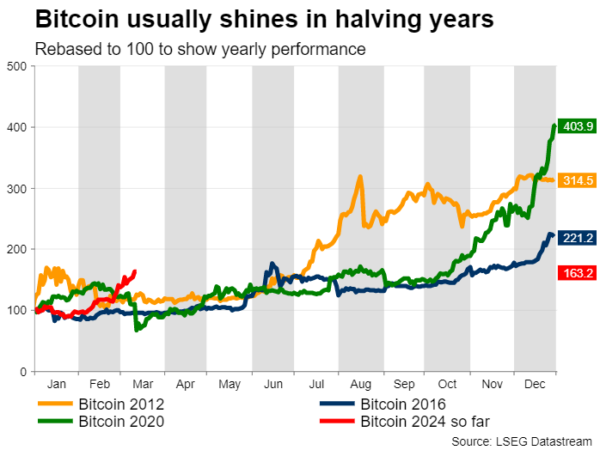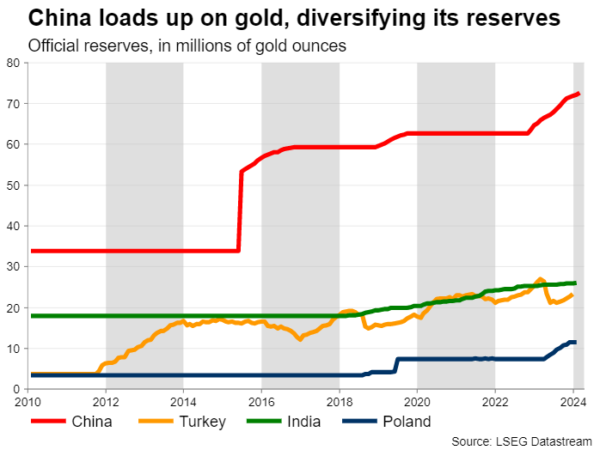- Gold and Bitcoin cruise to new all-time highs simultaneously
- However, there are different drivers behind these rallies
- Overall, both assets might have more scope to run higher
Gold and bitcoin go through the roof
It’s pretty rare to see gold and bitcoin setting new record highs at the same time. Gold is considered the ultimate safe haven asset, while bitcoin is often viewed as one of the riskiest and most speculative plays. When both of them stage an incredible rally, it sends mixed signals about the mood in global markets.
Yet, the catalysts behind each rally are quite different. The only common characteristic is that both gold and bitcoin have benefited from speculation that the Fed is about to slash interest rates. Aside from that, each asset has been driven higher by its own unique forces.
Gold has been turbocharged by direct purchases from central banks, with China leading the charge. Beijing is trying to diversify its reserves away from the US dollar, after the US weaponized the dollar in its sanctions against Russia. China is worried about suffering the same fate in case its relations with America deteriorate.
Chinese consumers have gone on a buying spree as well, searching for protection from the crash in the nation’s property and equity markets. This local demand for gold is evident when comparing prices – gold in Shanghai is trading at a significant premium over the same gold in London.
Safe haven flows have been another source of fuel for gold prices. The geopolitical landscape is unstable and some investors might also be buying gold as a hedge against a recession, as economic growth is losing steam in several regions.
What’s behind Bitcoin’s ascent?
In the crypto arena, bitcoin has enjoyed increased interest from institutional investors following the launch of spot ETFs last year. These contracts have granted the ‘big players’ easier and safer exposure to the famous coin.
One signal that bitcoin’s ascent is being driven by ‘smart money’ is that smaller alternative coins are nowhere close to their own record highs. Hence, investors are displaying a clear preference for higher quality and less volatile crypto holdings, rather than simply chasing gains.
Another element behind bitcoin’s meteoric rise has been the prospect of reduced supply growth, ahead of next month’s halving event. This is a process by which the reward for mining new blocks of bitcoin is cut in half, reducing the rate at which new bitcoins are generated.
Slower supply growth often leads to higher prices. Indeed, bitcoin prices have risen in the aftermath of previous halving events, and this time around, traders seem to be frontrunning this move.
Can the rallies stretch further?
With both gold and bitcoin trading in uncharted waters, the question on everyone’s mind is whether these rallies can stretch even further. In a nutshell, the answer might be ‘yes’.
Let’s start with gold. Central banks have purchased record amounts of gold over the last couple of years, and this process will likely continue as the standoff between the United States and China heats up, especially if Donald Trump is re-elected president.
China has been loading up on gold, but gold still represents only 4.3% of the nation’s total foreign exchange reserves. Hence, there’s plenty of scope for that number to keep rising, keeping demand for bullion at elevated levels.
Similarly, gold can still draw support from interest rates falling. Speculation around rate cuts has pushed bond yields lower, which has boosted the yellow metal that pays no yield to hold. But yields are still quite high from a historical perspective, trading near their highest levels in a decade. This suggests gold can still capitalize on yields falling back to more ‘normal’ levels, particularly if the US economy weakens, forcing the Fed to slash interest rates deeper and faster.
As for bitcoin, the outlook still appears positive ahead of the halving event on April 20th, which in previous instances has benefited prices. At the same time, the king of crypto is increasingly entering institutional portfolios as an alternative asset. Even if it makes up only a tiny fraction of such portfolios, those inflows are still significant for a market as small as crypto.
That said, there might be an even stronger bull case for Ethereum, the second biggest cryptocurrency. Ethereum is still 17% below its own record highs, but with spot ETFs on the horizon, it might be only a matter of time until it attracts the same ‘smart money’ flows as bitcoin did recently.
Applications for spot Ethereum ETFs are still pending approval by US regulators, which could be granted later this year.
















